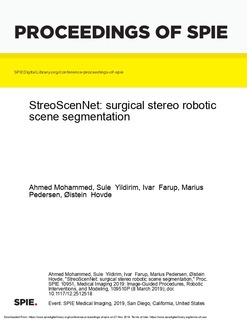| dc.contributor.author | Mohammed, Ahmed Kedir | |
| dc.contributor.author | Yildirim Yayilgan, Sule | |
| dc.contributor.author | Farup, Ivar | |
| dc.contributor.author | Pedersen, Marius | |
| dc.contributor.author | Hovde, Øistein | |
| dc.date.accessioned | 2019-11-27T08:38:33Z | |
| dc.date.available | 2019-11-27T08:38:33Z | |
| dc.date.created | 2019-08-21T16:18:05Z | |
| dc.date.issued | 2019 | |
| dc.identifier.issn | 1605-7422 | |
| dc.identifier.uri | http://hdl.handle.net/11250/2630676 | |
| dc.description.abstract | Surgical robot technology has revolutionized surgery toward a safer laparoscopic surgery and ideally been suited for surgeries requiring minimal invasiveness. Sematic segmentation from robot-assisted surgery videos is an essential task in many computer-assisted robotic surgical systems. Some of the applications include instrument detection, tracking and pose estimation. Usually, the left and right frames from the stereoscopic surgical instrument are used for semantic segmentation independently from each other. However, this approach is prone to poor segmentation since the stereo frames are not integrated for accurate estimation of the surgical scene. To cope with this problem, we proposed a multi encoder and single decoder convolutional neural network named StreoScenNet which exploits the left and right frames of the stereoscopic surgical system. The proposed architecture consists of multiple ResNet encoder blocks and a stacked convolutional decoder network connected with a novel sum-skip connection. The input to the network is a set of left and right frames and the output is a mask of the segmented regions for the left frame. It is trained end-to-end and the segmentation is achieved without the need of any pre- or post-processing. We compare the proposed architectures against state-of-the-art fully convolutional networks. We validate our methods using existing benchmark datasets that includes robotic instruments as well as anatomical objects and non-robotic surgical instruments. Compared with the previous instrument segmentation methods, our approach achieves a significant improved Dice similarity coefficient. | nb_NO |
| dc.language.iso | eng | nb_NO |
| dc.publisher | Society of Photo-optical Instrumentation Engineers (SPIE) | nb_NO |
| dc.title | StreoScenNet: Surgical stereo robotic scene segmentation | nb_NO |
| dc.type | Journal article | nb_NO |
| dc.type | Peer reviewed | nb_NO |
| dc.description.version | publishedVersion | nb_NO |
| dc.source.volume | 1095:109510P1 | nb_NO |
| dc.source.journal | Progress in Biomedical Optics and Imaging | nb_NO |
| dc.identifier.doi | 10.1117/12.2512518 | |
| dc.identifier.cristin | 1717802 | |
| dc.relation.project | Norges forskningsråd: 247689 | nb_NO |
| dc.description.localcode | © 2019 Society of Photo Optical Instrumentation Engineers. One print or electronic copy may be made for personal use only. Systematic reproduction and distribution, duplication of any material in this paper for a fee or for commercial purposes, or modification of the content of the paper are prohibited. | nb_NO |
| cristin.unitcode | 194,63,10,0 | |
| cristin.unitcode | 194,63,30,0 | |
| cristin.unitname | Institutt for datateknologi og informatikk | |
| cristin.unitname | Institutt for informasjonssikkerhet og kommunikasjonsteknologi | |
| cristin.ispublished | true | |
| cristin.fulltext | preprint | |
| cristin.qualitycode | 1 | |
